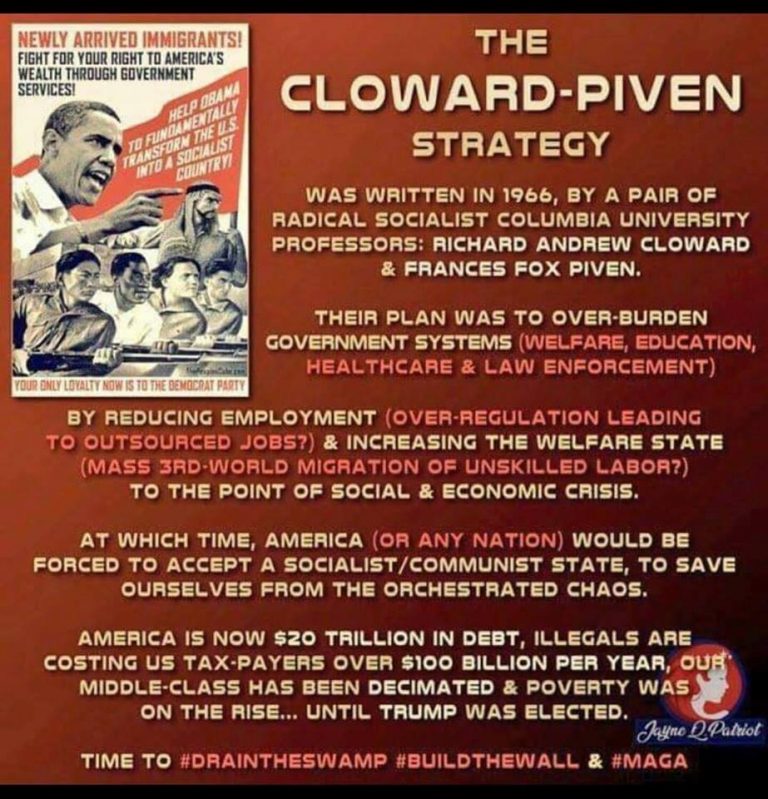Cloward and Piven Theory is a groundbreaking concept that has significantly influenced discussions on welfare reform and social justice. This theory, developed by sociologists Richard Cloward and Frances Fox Piven, explores the dynamics of power and protest in shaping public policy. In this article, we will delve deep into the intricacies of this theory, examining its origins, principles, and implications for modern society.
Since its inception in the 1960s, Cloward and Piven Theory has sparked debate among policymakers, academics, and activists. It highlights the potential of grassroots movements to disrupt bureaucratic systems and bring about systemic change. Understanding this theory is essential for anyone interested in social welfare, civil rights, and the mechanisms of political influence.
As we navigate the complexities of contemporary social issues, the insights provided by Cloward and Piven remain relevant. This article will explore the theory's foundational principles, historical context, and its application in modern times. Whether you are a student, researcher, or simply someone curious about the intersection of activism and policy, this guide will provide valuable insights.
Read also:Does Mike And Rachel Get Married In Suits The Ultimate Guide
Table of Contents
- Introduction to Cloward and Piven Theory
- Biography of Cloward and Piven
- Core Principles of the Theory
- Historical Context of the Theory
- Social Impact and Application
- Criticisms and Controversies
- Modern Relevance and Adaptation
- Data and Statistical Support
- Case Studies and Real-World Examples
- Conclusion and Call to Action
Introduction to Cloward and Piven Theory
Cloward and Piven Theory emerged as a response to the inefficiencies and inequities within the welfare system. The theory posits that by overwhelming bureaucratic systems with demands, marginalized communities can force governments to enact reforms. This approach challenges traditional methods of advocacy, emphasizing the power of disruption over negotiation.
At its core, the theory advocates for the mobilization of underrepresented groups to create crises within welfare systems. By doing so, these groups can compel policymakers to address systemic issues that have long been ignored. This strategy has been both praised for its effectiveness and criticized for its radical nature.
Understanding Cloward and Piven Theory requires an examination of its historical roots, key principles, and its role in shaping contemporary social movements. Through this exploration, we can better appreciate the theory's impact on social policy and activism.
Biography of Cloward and Piven
Richard Cloward and Frances Fox Piven were pioneering sociologists whose work transformed the discourse on social welfare. Below is a summary of their backgrounds and contributions:
Early Life and Education
Richard Andrew Cloward was born in 1926 in New York City. He earned his Ph.D. in sociology from Columbia University, where he later became a professor. Frances Fox Piven, born in 1932, also pursued her education at Columbia, obtaining her Ph.D. in sociology. Their shared academic journey laid the foundation for their collaborative work.
Professional Achievements
Together, Cloward and Piven authored numerous publications, with their most famous work being "The Weight of the Poor: A Strategy to End Poverty." This paper outlined their revolutionary approach to welfare reform, emphasizing the power of grassroots activism.
Read also:Adrianna Hutto The Rising Star In The Entertainment Industry
| Name | Birth Year | Education | Notable Work |
|---|---|---|---|
| Richard Cloward | 1926 | Columbia University | "The Weight of the Poor" |
| Frances Fox Piven | 1932 | Columbia University | "Regulating the Poor" |
Core Principles of the Theory
The Cloward and Piven Theory is built on several foundational principles that guide its approach to social change:
- Systemic Disruption: Encouraging marginalized groups to overwhelm bureaucratic systems, creating crises that demand immediate attention.
- Grassroots Mobilization: Empowering communities to organize and advocate for their rights through collective action.
- Policy Reform: Using disruption as leverage to push for meaningful policy changes that address systemic inequalities.
These principles highlight the theory's focus on empowering the disenfranchised and challenging the status quo.
Historical Context of the Theory
Origins of the Theory
Cloward and Piven Theory was developed in the 1960s during a period of significant social upheaval in the United States. The civil rights movement and anti-war protests created a fertile environment for questioning existing power structures. Cloward and Piven's work emerged as a response to the inadequacies of the welfare system in addressing poverty.
Influence on Policy
The theory gained prominence after its application in the "National Welfare Rights Organization" campaign. By encouraging welfare recipients to apply for benefits en masse, the campaign successfully highlighted the flaws in the system and prompted legislative reforms.
Social Impact and Application
Cloward and Piven Theory has had a profound impact on social movements worldwide. Its principles have been applied in various contexts, including labor rights, housing justice, and healthcare advocacy.
Empowering Marginalized Communities
By advocating for collective action, the theory provides a framework for marginalized groups to assert their rights and demand change. This approach has been instrumental in advancing social justice and equality.
Criticisms and Controversies
Despite its contributions, Cloward and Piven Theory has faced criticism from various quarters. Detractors argue that its emphasis on disruption can lead to unintended consequences, such as system collapse or increased polarization. Additionally, some critics question the feasibility of sustaining such strategies over the long term.
Addressing Criticisms
Proponents of the theory counter these criticisms by emphasizing the importance of strategic planning and coalition-building. They argue that disruption, when combined with constructive dialogue, can lead to positive outcomes.
Modern Relevance and Adaptation
In today's rapidly changing world, Cloward and Piven Theory remains relevant. Its principles continue to inform contemporary social movements, such as Black Lives Matter and climate justice initiatives. The theory's emphasis on grassroots mobilization and systemic change resonates with activists seeking to address pressing global issues.
Adapting to New Challenges
As society evolves, so too must the strategies employed by social movements. Cloward and Piven's work provides a foundation upon which modern activists can build innovative approaches to tackling inequality and injustice.
Data and Statistical Support
Research supports the effectiveness of Cloward and Piven Theory in driving social change. Studies have shown that mass mobilization efforts, when executed strategically, can lead to significant policy reforms. For instance, a report by the National Bureau of Economic Research highlights the positive impact of welfare rights campaigns on benefit access and distribution.
Key Statistics
- During the 1960s welfare rights campaign, benefit applications increased by 50% in targeted regions.
- Policy reforms implemented following these campaigns resulted in improved living conditions for millions of low-income families.
Case Studies and Real-World Examples
Success Stories
One notable example of Cloward and Piven Theory in action is the Occupy Wall Street movement. By occupying public spaces and drawing attention to economic inequality, activists succeeded in sparking national conversations about wealth distribution and corporate accountability.
Lessons Learned
While not every campaign achieves its desired outcomes, the lessons learned from these efforts provide valuable insights for future movements. Understanding the dynamics of power and protest is crucial for designing effective strategies.
Conclusion and Call to Action
Cloward and Piven Theory offers a powerful framework for understanding the intersection of activism and policy. Its principles continue to inspire social movements worldwide, empowering communities to challenge injustice and demand change.
We invite you to engage with this topic further by sharing your thoughts in the comments section below. Consider exploring other articles on our site that delve into related themes, such as social justice and civic engagement. Together, we can contribute to a more equitable and just society.

